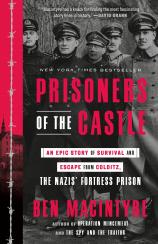Prisoners of the Castle: An Epic Story of Survival and Escape from Colditz, the Nazis' Fortress Prison
Review
Prisoners of the Castle: An Epic Story of Survival and Escape from Colditz, the Nazis' Fortress Prison
The story of Colditz Castle’s unusual role in WWII has been recounted in memoirs, movies and histories. Much of it, according to British author Ben Macintyre, focused on a few great feats, while ignoring what life was like for the four years it functioned as Nazi Germany’s maximum security prison for Allied officers. In 1939, the officers who were deemed deutschfeindlich, or “German-unfriendly,” and were likely to try to escape were sent there. These men did their best to survive the boredom and fear, along with deprivations and, in some cases, the physical pains of capture. Many did attempt to escape, though only a small number made it home.
Originally the castle was for all Allied troops, including French, Polish, Dutch and English, before becoming a prison for mainly blue-blood English officers in 1943. To the status-minded British, with their history of public schools and class system, the prison soon reflected their homeland: aides for the officers, clubs based on social standing, book discussions (parcels were regularly delivered to the castle), and sexual repression.
"Macintyre takes a potentially static story --- men locked in a prison for years --- and brings the characters...and the castle itself to life."
Macintyre takes a potentially static story --- men locked in a prison for years --- and brings the characters, including Reinhold Eggers, the anglophile security chief, and the castle itself to life. Some of the inmates, like Pat Reid, who took part in many escape plans, are well known. But others, like an Indian doctor who was suspected of supporting a pro-Nazi Indian independence leader, and David Stirling, who ran a spy network with Leipzig locals, are also highlighted.
Even those whose stories are known, like British army officer Airey Neave, who marched out of Colditz dressed in a fake German uniform, help explain why this is a history of something bigger than one dank prison. Neave would later join MI9, the British Intelligence operation set up to help Allied fighters escape imprisonment or avoid capture in enemy territory. He eventually became a ranking member of Parliament before being assassinated by Irish terrorists in 1979.
Unsurprisingly, much of PRISONERS OF THE CASTLE retells the adventures of the various escapees --- some of whom tried multiple times, getting as far as the border before being turned in and sent back to the castle. It was, as Eggers wrote in his memoir, “a permanent game of leapfrog: first we were ahead with our security barriers, then they were, scheming around them.” Men would take the costumes and makeup used for plays (which were regularly performed) to fit themselves out like guards, old women and villagers. Tunnels were dug. Most ingenious was the glider, nicknamed the Colditz Cock, that was to be launched from the prison roof. While only 33 men achieved their freedom, talking about it and working for it became a way to keep hope alive.
As Nazi Germany was overrun, veterans of Colditz wondered if they would be liberated, used as leverage to win high-ranking Nazis’ freedom, or taken somewhere to be massacred. Despite increasing privations, most wanted to stay put and wait for the Allies to arrive. As Macintyre writes, “The prisoners had spent more than four years trying to get out of the castle; now, it seemed, they might have to fight the Germans in order to stay in it.”
On April 16, 1945, the prisoners took charge of Colditz after negotiating a secret surrender with their captors.
Reviewed by Lorraine W. Shanley on September 23, 2022
Prisoners of the Castle: An Epic Story of Survival and Escape from Colditz, the Nazis' Fortress Prison
- Publication Date: August 1, 2023
- Genres: History, Nonfiction
- Paperback: 384 pages
- Publisher: Crown
- ISBN-10: 0593136357
- ISBN-13: 9780593136355




